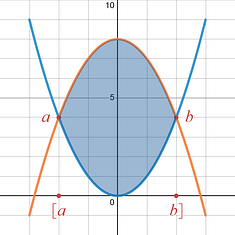Method: Disk Method
90% of the Disk Method process will be in the setup. The key to the process will always be defining your region, and finding our radius equation , R(x) . Having a good working knowledge of the standard family of graphs (i.e., linear, quadratic, cubic, square root, exponential, trig) will be required.
Step 1: Draw out the region that you are being asked to rotate.
Use the equation(s) you were given to draw out the region you are being asked to rotate .
This is where your knowledge of the standard families of graphs will be put to the test.
Step 2: Determine the axis you are begin asked to revolve or rotate your region around.
You will be told around which axis they would like to you to rotate your region. It will often times be the x-axis or the y-axis . However, the axis could also be another horizontal for vertical line entirely (i.e., y = 2 or x = 3 ).
The language often used to identify the axis is “about the …”
Step 3: Determine whether your equation is in terms of x (standard: ) or in terms of y (non-standard: ).
The axis of revolution will also tell you whether you need to take your integral with respect to x , dx , or whether you need to take it with respect to y , dy .
- If you are given the axis of revolution as the x-axis or a y =__ (a horizontal axis ), then you would need your equation in terms of x (standard: ).
- If you are given the axis of revolution as the y-axis or a x=__ (a vertical axis ), then you would need your equation in terms of y (non-standard: ).
Step 4: Determine the bounds of the integral, , for each of your enclosed regions.
- Your bounds are either going to be the intersection of your two equations, or they will be defined by an equation you were given.
|
Intersections as Bounds
|
Equations as Bounds
|
- If you are given an actual graph to work from, then you should be able to just read the bounds of your integral straight off the graph.
- If you are given equations and allowed to use your calculator, then you will be able to calculate the intersects of your two graphs using the Calc–Intersect function on your TI-84 calculator.
- When the region is closed off (bounded) on the left and right side by additional given equations which are vertical lines (i.e., x=2 , x=5 ), then those vertical lines will create your bounds.
- Sometimes you will be given only the equations, you will not be allowed to use your calculator, and you will have to calculate the intersects of those two equations by setting the two equations equal to each other and solving for the intersects (solving for x ).
Step 5: Determine your radius equation, .
- If you are rotating strictly around the standard x-axis or the y-axis , then the given equation you are asked to rotate is your R(x) equation.
You may need to solve that equation so that it is in terms of x or in terms of y , but the given equation is the R(x) equation.
- If you are rotating around a nonstandard axis , perhaps y = 6 or x = 4 , then you will need to create a new equation for the R(x) equation.
In these situations, you will need to apply the Top minus Bottom concept to create the R(x) equation.
You have a given equation and an axis of revolution equation . One of those equations is the Top and one of those equations is the Bottom. You will need to review your sketch to decide which is which.
Step 6: Setup and evaluate your Disk Methodintegral.
Use the results of Step 4 (your bounds ) and Step 5 (your R(x) equation) together using the Disk Methodintegral setup.



